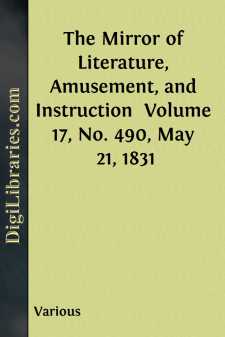Categories
- Antiques & Collectibles 13
- Architecture 36
- Art 48
- Bibles 22
- Biography & Autobiography 813
- Body, Mind & Spirit 142
- Business & Economics 28
- Children's Books 16
- Children's Fiction 13
- Computers 4
- Cooking 94
- Crafts & Hobbies 4
- Drama 346
- Education 46
- Family & Relationships 57
- Fiction 11829
- Games 19
- Gardening 17
- Health & Fitness 34
- History 1377
- House & Home 1
- Humor 147
- Juvenile Fiction 1873
- Juvenile Nonfiction 202
- Language Arts & Disciplines 88
- Law 16
- Literary Collections 686
- Literary Criticism 179
- Mathematics 13
- Medical 41
- Music 40
- Nature 179
- Non-Classifiable 1768
- Performing Arts 7
- Periodicals 1453
- Philosophy 64
- Photography 2
- Poetry 896
- Political Science 203
- Psychology 42
- Reference 154
- Religion 513
- Science 126
- Self-Help 84
- Social Science 81
- Sports & Recreation 34
- Study Aids 3
- Technology & Engineering 59
- Transportation 23
- Travel 463
- True Crime 29
The Mirror of Literature, Amusement, and Instruction Volume 17, No. 490, May 21, 1831
by: Various
Categories:
Description:
Excerpt
This crazy, but not unpicturesque building, was taken down in the autumn of last year, in forming an approach to the New London Bridge. It stood on the eastern side of the High-street, and is worthy of record among the pleasing relics of antiquity, which it has ever been the object of The Mirror to rescue from oblivion. Its style of architecture—that of the seventh Henry—is interesting: there is a florid picturesqueness in the carvings on the fronts of the first and second stories, and probably this ornament extended originally to the uppermost stories, which had subsequently been covered with plaster.
We remember the house for the last twenty years, but cannot trace this or any other alteration in its front. The windows, it will be seen, are of different periods, those on the right-hand second and the left-hand third floor being of the oldest date.
Apart from these attractions, and as a specimen of the olden domestic architecture of the metropolis, the annexed Cut bears an historic interest, in its having been the residence of the ill-starred Anne Boleyn, queen of Henry the Eighth. The interior was in palatial style, having been elaborately finished; and in one of the apartments, we learn that the royal arms were very conspicuous.
In early times, Southwark was one of the most celebrated of the metropolitan suburbs; and it is much to be regretted that the liberality of our times has not encouraged the production of its ancient history. Every one at all familiar with London is aware of the antiquity of St. Saviour's Church, the original foundation of which was from the profits of a ferry over the Thames, whence its original name, St. Mary Overy, or "over the ferry." This was some time before the Conquest; but the church was principally rebuilt in the fourteenth century. We have spoken of its ancient fame elsewhere. Bankside, its name in spiritual and secular story, is likewise of some note. The early Bishops of Winchester had a palace and park here; remains of the former were laid open by a fire about seventeen years since. Then, who does not remember, in the love of sports and pastimes, the bull and bear-baiting theatres, and the uncouth glory of the Globe theatre, associated with the poet of all time—Shakspeare. Southwark was, therefore, a fitting site for a royal palace for occasional retirement, and its contiguity to the Thames must have enhanced its pleasantness.
Miss Benger, in her agreeable Memoirs of Anne Boleyn, does not mention the Queen's abode in Southwark; but the date of the architecture of the annexed house, and its closer identification with Queen Elizabeth, render the first mentioned circumstance by no means improbable. Previous to the marriage of Anne Boleyn, we learn that Henry passed not a few of his leisure hours "in the delightful society of Anne Boleyn." "Every day they met and spent many hours in riding or walking together." Her family at this time resided at Durham House, on the site of the Adelphi, and Anne frequently made excursions with Henry in the vicinity of London.
Of the antiquity of this district we could quote more proofs. The galleried inn-yards, and among them that at which the Pilgrims sojourned on their road to Canterbury, are among them. In our last volume too, at page 160, we engraved an ancient Vault in Tooley-street, the remains of the "great house, builded of stone, with arched gates, which pertained to the Prior of Lewis, in Sussex, and was his lodging when he came to London." Not far from this was "another great House of Stone and Timber," which, in the thirteenth century, was held of John, "Earl Warren, by the Abbot of St....












